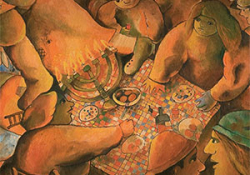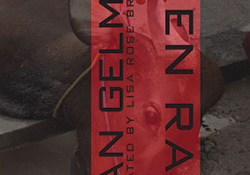de atrásalante en su porfía by Juan Gelman
Mexico City. Ediciones Era: Dirección de Literatura / UNAM. 2010. 186 pages. $21.95. isbn 978-607-445-030-9

Juan Gelman (b. 1930, Buenos Aires), whom readers and critics have often accurately classified as a socially committed poet, continues a lifelong commitment to poetry in de atrásalante en su porfía, which appears more than twenty-five books and half a century after his first collection, Violín y otras cuestiones (1956). His life's work has earned Gelman two of Spanish-language literature's most prestigious awards, the Juan Rulfo in 2000 and the Cervantes in 2007.
Gelman's poems form a tight weave with his life. His opposition to the Argentine government forced him into exile in 1975. Gelman's son was murdered after Argentine security forces kidnapped him and his pregnant wife in 1976. In 2000 Gelman was reunited with his granddaughter in Uruguay after years of searching for the child of his still-missing daughter-in-law. Gelman's poetry thus illuminates themes of loss, memory, and reunion, which many of the poems in de atrásalante combine with a brilliant consideration and, more importantly, demonstration, of language's expressive capacity.
The collection consists of about 165 short poems, most of which are between ten and twenty lines long. The best poems demonstrate the written word's potential for surprising malleability, which Gelman crafts with skill, especially in regard to syntax and rhythm. Consider the following example from the poem "Nácares," whose alternating lines of different length, when read separately, create new images and meanings: "En la calle de los otoños mínimos, / el cuerpo iluminante / pasa la voz que dura lo que dura, / aparta su palabra de / los cielos que acuñaban dioses, / barcas hundidas por / grillos que no se supo oír." (In the street of minimal autumns / the illuminating body / passes the voice that lasts what it lasts / separates its word from / the skies that cradled gods / boats sunk by / crickets that didn't know how to hear.) Images of autumn, speaking, divinity, ships, and listening are typical of the entire collection, which contemplates with frustration and stubborn determination the back-and-forth movement between expression and experience. Hence the collection's title, which in English would read something like "from backtofront in its tenacity."
Thematic and formal oscillation is evident in "Por qué no," which features two consecutive lines of the same length whose symmetry highlights the key words "eco" and "te" (echo and you): "Sonido de eco no es sonido, / espejo que te mira no es vos." (Sound of an echo is not sound / mirror that watches you is not you.) These aural and visual reflections emphasize the distance between original and copy, self and other. By respecting this distance, Juan Gelman's poems attest to language's vitality, which would be dampened in the hands of a writer who tried too hard to anchor it to the world it strives to express.
Ryan Long
University of Oklahoma




